就像其他变量或常量一样,您必须在使用指针存储其他变量地址之前,对其进行声明。 然后在程序中才能使用它们,指针需要符合C的命名规则。
指针声明具有以下形式:
|
1 |
data_type * pointer_variable_name; |
- data_type 是指针的基本类型,它必须是一个有效的 C 数据类型,反映了指向的变量的数据类型;
- pointer_variable_name 是指针变量的名称;
- * – 用来声明指针的星号 (间接寻址运算符)* 与乘法中使用的星号是相同的。但是,在这个语句中,星号是用来指定一个变量是指针。
例如:
|
1 2 3 4 |
int *ip; /* 一个整型的指针 */ double *dp; /* 一个 double 型的指针 */ float *fp; /* 一个浮点型的指针 */ char *ch; /* 一个字符型的指针 */ |
所有实际数据类型,不管是整型、浮点型、字符型,还是其他的数据类型,对应指针的类型都是一样的,都是一个代表内存地址的十六进制数。
不同数据类型的指针之间唯一的不同是,指针所指向的变量或常量的数据类型不同。
指针变量同普通变量一样,使用之前不仅要定义说明,而且必须赋予具体的值。未经赋值的指针变量不能使用,否则将造成系统混乱,甚至死机。指针变量的赋值只能赋予地址,决不能赋予任何其它数据,否则将引起错误。在C语言中,变量的地址是由编译系统分配的,对用户完全透明,用户不知道变量的具体地址。
声明指针之后,我们像使用变量地址的标准变量一样对其进行初始化。 如果指针未在程序中初始化和使用,则结果将不可预测,并且可能会造成灾难性的后果。
要获取变量的地址,我们使用连字号(&)运算符,并在需要其地址的变量名称之前放置。
|
1 |
pointer = &variable; |
例1.指针和变量的关系
#include <stdio.h>
int main()
{
int a=10; //variable declaration
int *p; //pointer variable declaration
p=&a; //store address of variable a in pointer p
printf("Address stored in a variable p is:%x\n",p); //accessing the address
printf("Value stored in a variable p is:%d\n",*p); //accessing the value
return 0;
}
%x以十六进制数形式输出整数
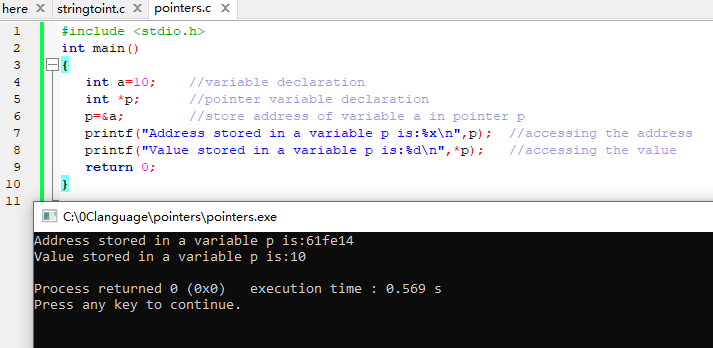
直接和间接访问变量内容
在C语言中,有两种等效的方法来访问和操作变量内容
- 直接访问:我们直接使用变量名
- 间接访问:我们使用指向变量的指针
例2. 通过指针交换两个变量的值
|
1 2 3 4 5 6 7 8 9 10 11 12 13 14 |
main () { int *a,*b,*c; /* Declr ptrs */ int A,B; /* Declare storage */ A = 12; /* Initialize storage */ B = 9; a = &A; /* Initialize pointers */ b = &B; printf ("%d %d\n",*a,*b); c = a; /* swap pointers */ a = b; b = c; printf ("%d %d\n",*a,*b); } |
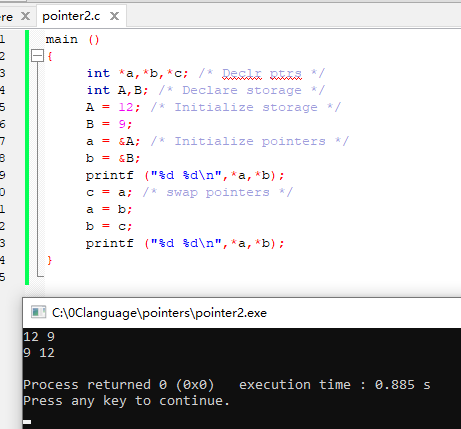
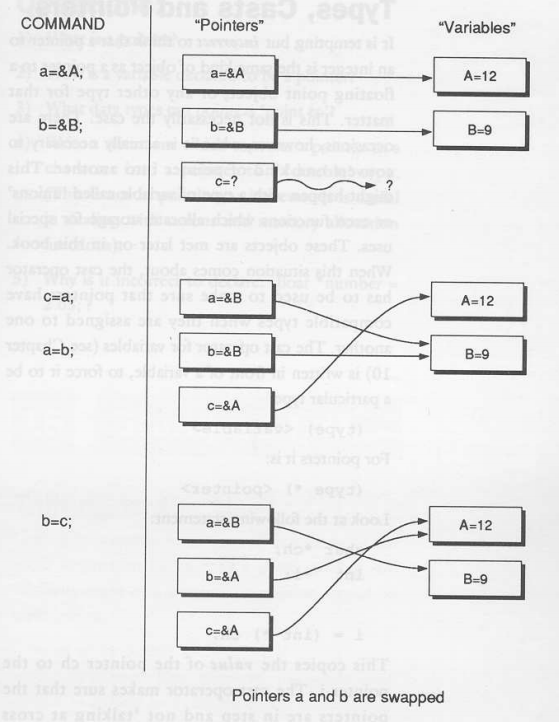
例3.指针变量和直接取址运算符和间接取址运算符的应用 (一个程序了解指针和地址)
#include <stdio.h>
int main()
{
int* pc, c;
c = 22;
printf("Address of c: %p\n", &c);
printf("Value of c: %d\n\n", c); // 22
pc = &c;
printf("Address of pointer pc: %p\n", pc);
printf("Content of pointer pc: %d\n\n", *pc); // 22
c = 11;
printf("Address of pointer pc: %p\n", pc);
printf("Content of pointer pc: %d\n\n", *pc); // 11
*pc = 2;
printf("Address of c: %p\n", &c);
printf("Value of c: %d\n\n", c); // 2
return 0;
}
结果:
|
1 2 3 4 5 6 7 8 9 10 11 |
Address of c: 2686784 Value of c: 22 Address of pointer pc: 2686784 Content of pointer pc: 22 Address of pointer pc: 2686784 Content of pointer pc: 11 Address of c: 2686784 Value of c: 2 |
程序说明:
|
1 |
int* pc, c; |

在这里,创建了一个指针 pc 和一个普通变量 c,它们都是 int 类型。
由于 pc 和 c 最初未初始化,因此指针 pc 指向无地址或随机地址。而且,变量 c 有一个地址,但包含随机垃圾值。
2.
|
1 |
c = 22; |

这将 22 分配给变量 c。也就是说,22存储在变量c的内存位置。
3.
|
1 |
pc = &c; |

这将变量 c 的地址分配给指针 pc。
4.
|
1 |
c = 11; |
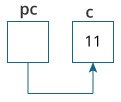
这将 11 分配给变量 c。
5.
|
1 |
*pc = 2; |
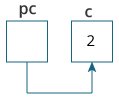
将指针 pc 指向的内存位置的值更改为 2
C语言指针应用的常见错误
[content_control]
假设,您希望指针 pc 指向 c 的地址。下列程序是错误的
|
1 2 3 4 5 6 7 8 9 10 11 12 13 |
int c, *pc; // pc is address but c is not pc = c; // Error // &c is address but *pc is not *pc = &c; // Error // both &c and pc are addresses pc = &c; // Not an error // both c and *pc values *pc = c; // Not an error |
这是初学者经常感到困惑的指针语法示例。
#include <stdio.h>
int main() {
int c = 5;
int *p = &c;
printf("%d", *p); // 5
return 0;
}
为什么我们在使用 int *p = &c; 时没有出错?
这是因为
|
1 |
int *p = &c; |
相当于:
|
1 2 |
int *p: p = &c; |
在这两种情况下,我们都在创建一个指针 p(不是 *p)并将 &c 分配给它。
为了避免这种混淆,我们可以使用如下语句:
|
1 |
int* p = &c; |
[/content_control]
